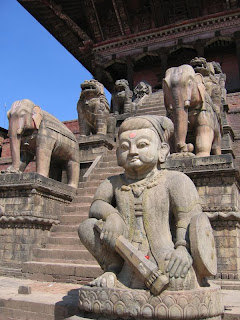 Bhaktapur is one of the three cities found in the Kathmandu Valley in Nepal not far from the capital city of Kathmandu. The name Bhaktapur means "City of devotees". Today this ancient, medieval city, from the fifteenth century, is part of the UNESCO World Heritage site, which records buildings that are of cultural and natural value universally.
Bhaktapur is one of the three cities found in the Kathmandu Valley in Nepal not far from the capital city of Kathmandu. The name Bhaktapur means "City of devotees". Today this ancient, medieval city, from the fifteenth century, is part of the UNESCO World Heritage site, which records buildings that are of cultural and natural value universally.In the eighteenth century Bhaktapur was known country-wide for its production of quality pottery pieces and beautiful art works, which included sculptures completed in both wood and stone. Today this reputation Bhaktapur has continues and is sustained by the tourist industry, which flourishes in this area. The city gives you a glimpse of what life was like centuries ago having changed very little since it was first formed.
Durbar Square can be found in the center of Bhaktapur and like Kathmandu contains many beautiful temples where the Nepalese people can go and pay homage to one of the many Hindu gods. At one point the square was crowded with temples and statues but with the 1934 earthquake many of these ancient buildings were destroyed and to this day have yet to be built again. In comparison to the city of Patan, the Bhaktapur Durbar Square is bigger and more neatly laid out but with many empty spaces where temples once stood.
One of the temples that are still in existence today is the Nyatapola Temple, which was built in 1702 A.D. under the rule of King Bhupatindra Malla. This beautifully sculptured building is considered one of the tallest pagodas in the country and is a lovely example of the immense workmanship that went into buildings of this type. This five-storey temple with a five-tier roof that stands just over thirty meters high can be reached by walking up a flight of steps that leads to the top of the platform. As you walk up these terraces you will notice that there are statues on either side of you, on every step.
The Nyatapola temple was built and dedicated to the goddess Siddhi Lakshmi or Siddhi Laxmi, providing the Nepalese with a place to worship her. Like so many of the other temples the image of the goddess that is contained with in the temple of Nyatapola is viewed strictly by the priests only.
Bhaktapur is one of the three cities found in the Kathmandu Valley in Nepal not far from the capital city of Kathmandu. The name Bhaktapur means "City of devotees". Today this ancient, medieval city, from the fifteenth century, is part of the UNESCO World Heritage site, which records buildings that are of cultural and natural value universally.
In the eighteenth century Bhaktapur was known country-wide for its production of quality pottery pieces and beautiful art works, which included sculptures completed in both wood and stone. Today this reputation Bhaktapur has continues and is sustained by the tourist industry, which flourishes in this area. The city gives you a glimpse of what life was like centuries ago having changed very little since it was first formed.
Durbar Square can be found in the center of Bhaktapur and like Kathmandu contains many beautiful temples where the Nepalese people can go and pay homage to one of the many Hindu gods. At one point the square was crowded with temples and statues but with the 1934 earthquake many of these ancient buildings were destroyed and to this day have yet to be built again. In comparison to the city of Patan, the Bhak
 tapur Durbar Square is bigger and more neatly laid out but with many empty spaces where temples once stood.
tapur Durbar Square is bigger and more neatly laid out but with many empty spaces where temples once stood.One of the temples that are still in existence today is the Nyatapola Temple, which was built in 1702 A.D. under the rule of King Bhupatindra Malla. This beautifully sculptured building is considered one of the tallest pagodas in the country and is a lovely example of the immense workmanship that went into buildings of this type. This five-storey temple with a five-tier roof that stands just over thirty meters high can be reached by walking up a flight of steps that leads to the top of the platform. As you walk up these terraces you will notice that there are statues on either side of you, on every step.
The Nyatapola temple was built and dedicated to the goddess Siddhi Lakshmi or Siddhi Laxmi, providing the Nepalese with a place to worship her. Like so many of the other temples the image of the goddess that is contained with in the temple of Nyatapola is viewed strictly by the priests only.

No comments:
Post a Comment